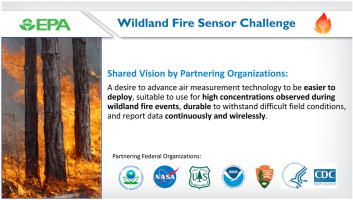Atmospheric Environment ( IF 4.2 ) Pub Date : 2021-01-16 , DOI: 10.1016/j.atmosenv.2020.118165 Matthew S Landis 1 , Russell W Long 1 , Jonathan Krug 1 , Maribel Colón 1 , Robert Vanderpool 1 , Andrew Habel 2 , Shawn P Urbanski 3

|
Wildland fires can emit substantial amounts of air pollution that may pose a risk to those in proximity (e.g., first responders, nearby residents) as well as downwind populations. Quickly deploying air pollution measurement capabilities in response to incidents has been limited to date by the cost, complexity of implementation, and measurement accuracy. Emerging technologies including miniaturized direct-reading sensors, compact microprocessors, and wireless data communications provide new opportunities to detect air pollution in real time. The U.S. Environmental Protection Agency (EPA) partnered with other U.S. federal agencies (CDC, NASA, NPS, NOAA, USFS) to sponsor the Wildland Fire Sensor Challenge. EPA and partnering organizations share the desire to advance wildland fire air measurement technology to be easier to deploy, suitable to use for high concentration events, and durable to withstand difficult field conditions, with the ability to report high time resolution data continuously and wirelessly. The Wildland Fire Sensor Challenge encouraged innovation worldwide to develop sensor prototypes capable of measuring fine particulate matter (PM2.5), carbon monoxide (CO), carbon dioxide (CO2), and ozone (O3) during wildfire episodes. The importance of using federal reference method (FRM) versus federal equivalent method (FEM) instruments to evaluate performance in biomass smoke is discussed. Ten solvers from three countries submitted sensor systems for evaluation as part of the challenge. The sensor evaluation results including sensor accuracy, precision, linearity, and operability are presented and discussed, and three challenge winners are announced. Raw solver submitted PM2.5 sensor accuracies of the winners ranged from ~22 to 32%, while smoke specific EPA regression calibrations improved the accuracies to ~75–83% demonstrating the potential of these systems in providing reasonable accuracies over conditions that are typical during wildland fire events.
中文翻译:

美国 EPA 荒地火灾传感器挑战:求解器提交的多污染物传感器系统的性能和评估
荒地火灾会释放大量空气污染,可能对附近人员(例如急救人员、附近居民)以及顺风人口构成风险。迄今为止,快速部署空气污染测量能力来应对事件受到成本、实施复杂性和测量准确性的限制。包括微型直读传感器、紧凑型微处理器和无线数据通信在内的新兴技术为实时检测空气污染提供了新的机会。美国环境保护署 (EPA) 与其他美国联邦机构(CDC、NASA、NPS、NOAA、USFS)合作赞助了荒地火灾传感器挑战赛。 EPA 和合作组织都希望推进荒地火灾空气测量技术,使其更易于部署,适合用于高浓度事件,并且能够持久承受困难的现场条件,并能够连续、无线地报告高时间分辨率数据。野火传感器挑战赛鼓励全球创新,开发能够在野火发生期间测量细颗粒物 (PM 2.5 )、一氧化碳 (CO)、二氧化碳 (CO 2 ) 和臭氧 (O 3 ) 的传感器原型。讨论了使用联邦参考方法 (FRM) 与联邦等效方法 (FEM) 仪器评估生物质烟雾性能的重要性。作为挑战赛的一部分,来自三个国家的十名求解者提交了传感器系统进行评估。展示并讨论了包括传感器准确度、精确度、线性度和可操作性在内的传感器评估结果,并宣布了三名挑战赛获胜者。原始求解器已提交 PM 2。获胜者的 5 个传感器精度范围为约 22% 至 32%,而针对烟雾的 EPA 回归校准将精度提高至约 75-83%,这证明了这些系统在荒地火灾事件期间的典型条件下提供合理精度的潜力。











































 京公网安备 11010802027423号
京公网安备 11010802027423号